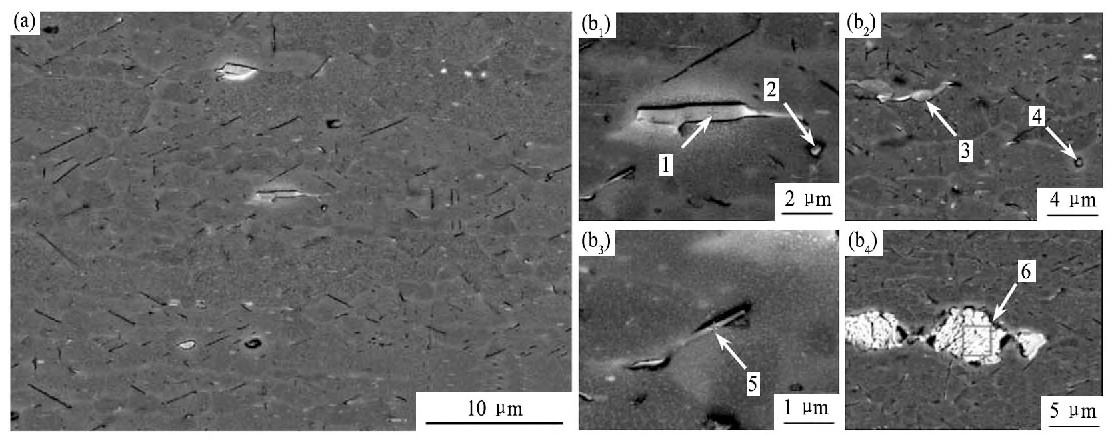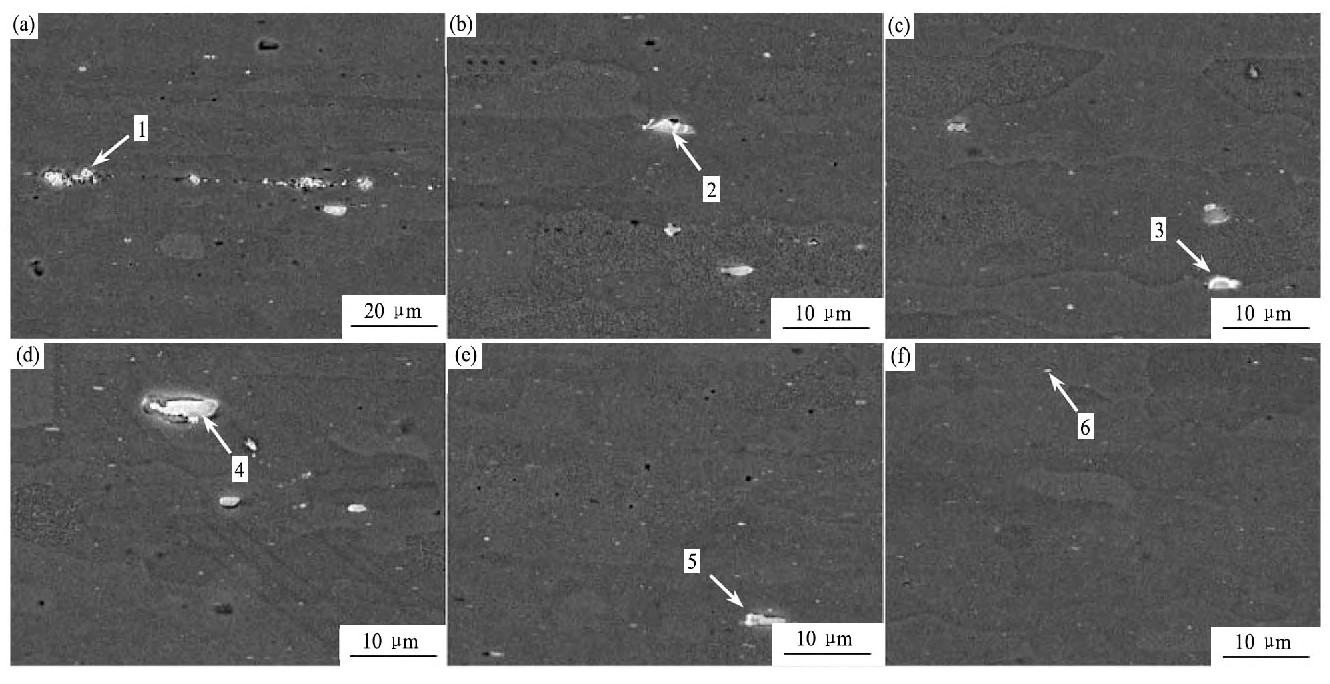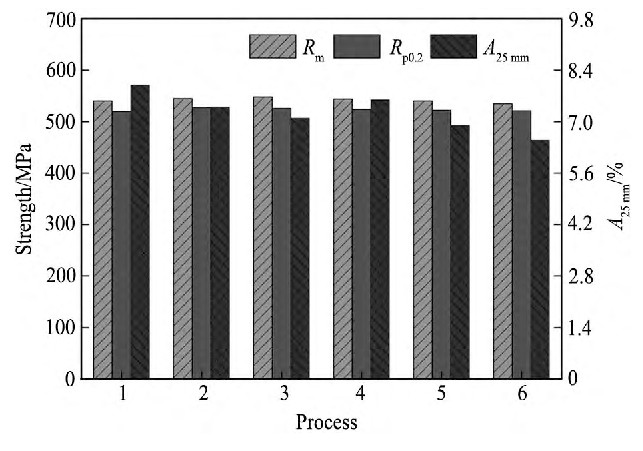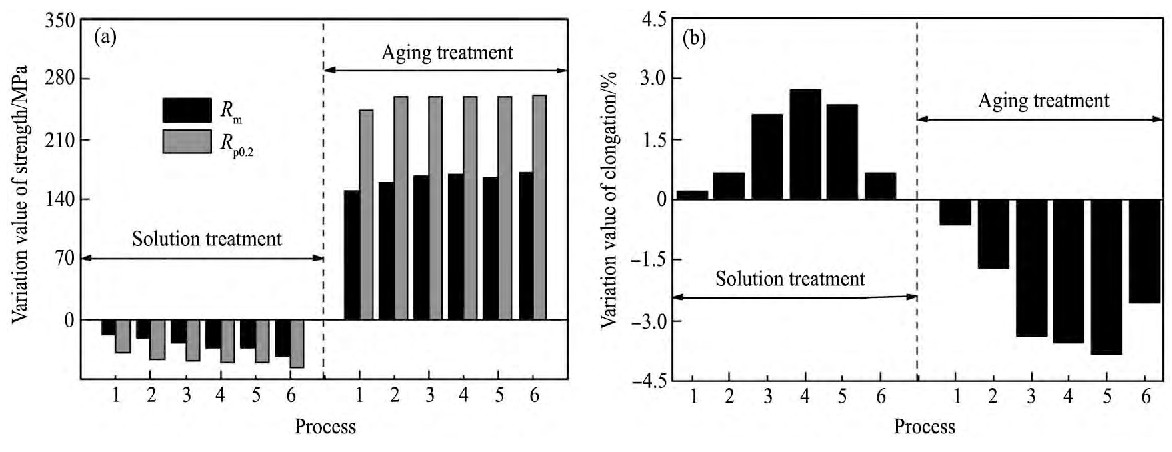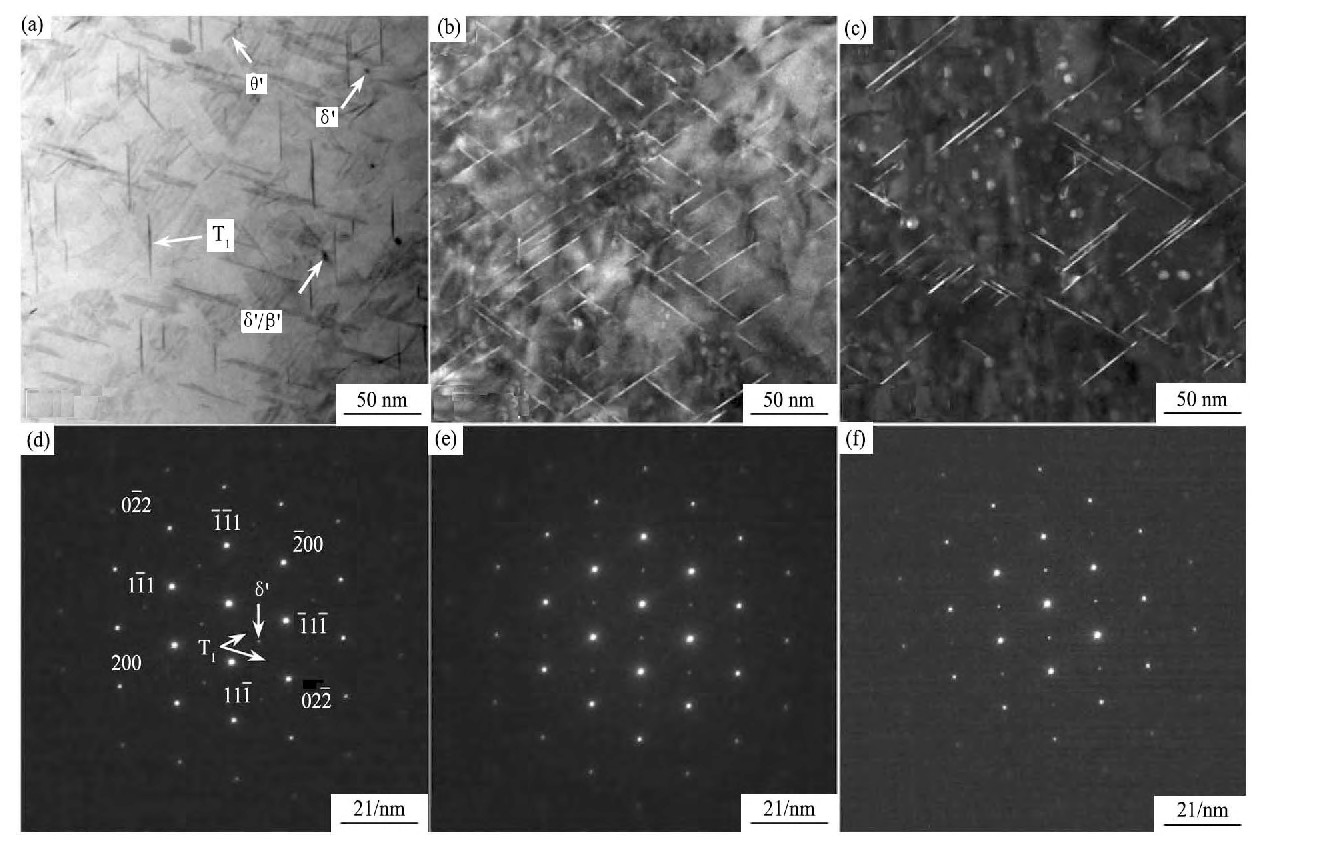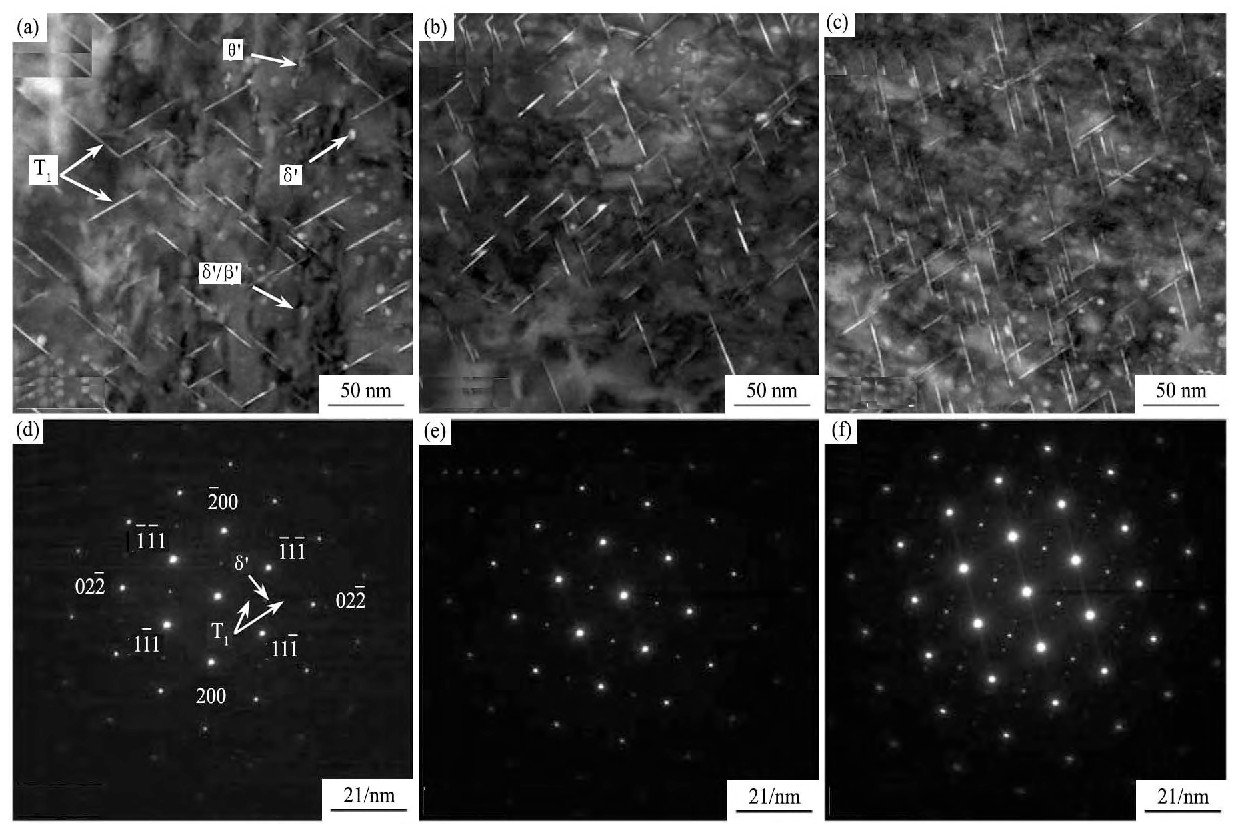网络首发时间: 2016-07-07 16:14
固溶工艺对2099合金组织性能的影响
浙江金马逊机械有限公司
北京有色金属研究总院国家有色金属复合材料工程技术研究中心
摘 要:
采用扫描电镜 (SEM) 、透射电镜 (TEM) 和力学性能测试等实验手段, 研究了单级固溶和强化固溶工艺对2099合金型材组织性能的影响规律。结果表明:型材基体中分布着呈球状或板条状的Al-Cu-Mg相及无规则的Al-Cu-Mn-Fe脆性相。固溶态下, 随着固溶或预固溶温度的升高, 粗大析出相的固溶效果得到明显改善, Al-Cu-Mg相基本上固溶到基体中, Al-Cu-Mn-Fe相的尺寸减小、数量降低, 但尚未完全固溶到基体中;合金的强度随着固溶或预固溶温度的升高而降低, 而塑性获得不同程度的提高。时效态下, 随着固溶或预固溶温度的升高, 合金塑性指标降低, 时效强化趋缓, 时效强化相演化规律表现为:T1相的密度增大, 尺寸减小, θ'相、δ'相及δ'/β'等亚稳相的比例减小。
关键词:
单级固溶;强化固溶;Al-Cu-Mg相;Al-Cu-Mn-Fe相;时效强化;
中图分类号: TG146.2;TG156.94
作者简介:张飞 (1985-) , 男, 内蒙古包头人, 博士, 研究员, 研究方向:铝合金压力加工及热处理, 电话:021-26649642, E-mail:zffreefly@126.com;
收稿日期:2015-12-01
基金:国家科技部重点基础研究发展计划项目 (2012CB619504) 资助;
Microstructure and Property of 2099 Alloy with Different Solid Solution Processes
Zhang Fei Shen Jian Lin Yaochen Chen Chaoyang Ye Dongdong
King-Mazon Machinery Co., Ltd.
National Engineering Research Center for Nonferrous Metal Composites, Beijing General Research Institute for Nonferrous Metals
Abstract:
Effects of single and strengthening solution processes on microstructure and properties of 2099 alloy were studied by scanning electron microscope (SEM) , transmission electron microscope (TEM) and mechanical property test. The results showed that spherical or lath-shaped Al-Cu-Mg phases and irregular Al-Cu-Mn-Fe phases were distributed in profile matrix. Under the solid solution treatment, the solid solution effect of coarse precipitation was improved greatly with the increase of solid solution or pre-solid solution temperature. Al-Cu-Mg phases nearly dissolved into the matrix, the size and quantity of Al-Cu-Mn-Fe phases decreased but did not completely dissolve into the matrix. The strength of 2099 alloy decreased while the elongation increased to some extent along with the increase of solid solution or pre-solid solution temperature. Under the aging treatment, the plastic index decreased with the increase of solid solution or pre-solid solution temperature, and the aging strengthening tended towards slow down. The evolution laws of the aging strengthening precipitation displayed that T1 phase increased in density with a smaller size, the proportion of metastable phases decreased, such as θ', δ' and δ'/β'.
Keyword:
single solution; strengthening solution; Al-Cu-Mg phases; Al-Cu-Mn-Fe phases; aging strengthening;
Received: 2015-12-01
锂 (Li) 作为自然界最轻的金属元素, 其密度约为铝的1/5, 在铝中每加入1%的Li, 可使合金密度减小3%, 弹性模量提高6%[1,2,3]。由于铝锂合金具有低密度、高比强度、高比刚度、优良的低温性能、良好的耐腐蚀性能和卓越的超塑成型性能, 用其取代常规铝合金, 可使构件质量减轻10%~15%, 刚度提高15%~20%[4,5,6,7,8]。2099合金作为第三代Al-Li合金, 由于其优良的物理机械性能和显著的经济优势, 使其成为航空航天新材料领域的新宠, 同时也是我国目前在研大飞机项目拟用高性能材料之一的主要原因[9,10,11]。目前, 2099合金已大量应用于制备A380和A350客机的结构件, 如:机翼纵梁 (2099-T8E67挤压件) 、地板梁和座椅导轨 (2099-T83挤压件) 、飞机的其他零部件 (2099-T8E77板材) [12,13]。
2099合金属于时效强化型合金, 为了充分发挥其时效析出强化性能, 获取过饱和固溶体是其必要前提。通常来讲, 固溶温度越高, 合金的过饱和度也就越高, 时效强化效果也就越好。然而, 固溶温度过高会使晶粒显著长大, 甚至会产生过烧现象, 导致力学性能显著恶化。相反, 固溶温度较低时, 二相粒子不能充分回溶, 对后续的时效强化产生不利影响[14,15]。因此, 合理的固溶制度对2099合金综合性能的改善具有重要的意义。因此, 本文分别研究了单级固溶与强化固溶工艺对2099合金组织性能的影响规律, 为该合金制定合理的固溶工艺奠定理论基础。
1 实验
实验材料为Φ92 mm×230 mm的2099合金棒材, 其均热制度为515℃/18 h+525℃/16 h, 化学成分如表1所示。将坯锭在630 t XJ-650型卧式挤压机上挤制成壁厚为2 mm的型材, 挤压温度、挤压速度和挤压比分别为420℃、2 mm·s-1和48。
表1 2099合金化学成分Table 1Chemical composition of 2099 alloy (%, mass fraction) 下载原图

表1 2099合金化学成分Table 1Chemical composition of 2099 alloy (%, mass fraction)
固溶处理在KSW-12-12A型箱式电阻炉中进行, 时效处理在DL-101-0BS型电热恒温鼓风干燥箱中完成。预变形及力学性能测试在WDW-100型微控电子万能试验机上进行, 拉伸速度为2 mm·min-1。组织观察在JEM 2100F型透射电子显微镜 (TEM) 上完成, 电解液为HNO3 (30 ml) +CH3OH (70 ml) , 双喷工艺参数为电压10~12 V, 电流50~60 m A, 采用液氮冷却, 电解液温度控制在-20℃以下。
2 结果与讨论
2.1 挤压态合金组织特征
图1为2099合金挤压态组织。可以发现, 沿挤压方向分布着大小形貌各异的第二相, 二相粒子大小从几微米到十几微米不等, 如图1 (a) 所示。能谱分析 (见表2) 表明, 呈板条状和细小球形的二相粒子主要是由Al-Cu-Mg相构成的金属间化合物, 如图1 (b1) , (b2) 和 (b3) 所示。与此同时, 基体中分布着粗大无规则的Al-Cu-Mn-Fe脆性相, 尺寸大小在5~12μm范围内, 如图1 (b4) 所示, 这种脆性相在后续的加工过程中容易破碎并形成裂纹源, 对合金强塑性水平的改善极为不利。
2.2 固溶工艺对固溶态合金组织性能的影响
表3为2099合金的固溶工艺, 图2为不同固溶工艺对应的二相粒子形貌特征。可以发现, 单级固溶条件下, 随着固溶温度的升高合金中的球形和板条状二相粒子基本上回溶到基体中, 但基体中始终都存在无规则的、较大的Al-Mn-Cu-Fe脆性相 (见表4) , 这种Al-Mn-Cu-Fe脆性相尺寸由530℃时约8μm减小到560℃时的4μm左右, 如图2 (a) ~ (c) 所示, 表明固溶温度升高促进了该种脆性析出相的回溶。这种粗大的含Fe脆性相对合金性能有不利的影响, 在外部载荷作用下裂纹容易在脆性相与基体界面萌生、扩展、合并, 并最终导致合金的断裂。
图1 2099合金挤压态的组织Fig.1 Microstructure of 2099 alloy under extrusion state
(a) Second phases distribution; (b1) ~ (b4) Points of energy spectrum analysis
表2 挤压态合金中二相粒子能谱分析Table 2 Energy spectrum analysis for second phase particles of 2099 alloy 下载原图

表2 挤压态合金中二相粒子能谱分析Table 2 Energy spectrum analysis for second phase particles of 2099 alloy
表3 2099合金的固溶工艺Table 3 Solid solution process of 2099 alloy 下载原图
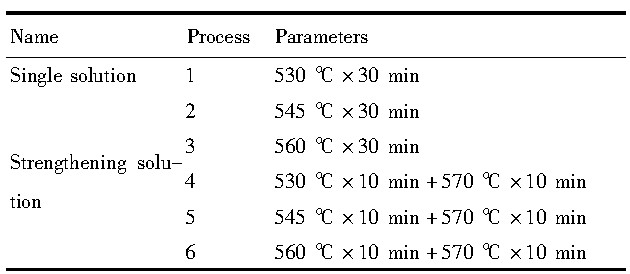
表3 2099合金的固溶工艺Table 3 Solid solution process of 2099 alloy
强化固溶条件下, 二相粒子数量较固溶前明显减少, 尺寸也显著减小, 然而局部区域仍可观察到尺寸较大的Al-Mn-Cu-Fe脆性相 (见表4) , 如图2 (d) 所示。预固溶温度由530℃升高到545℃, 相应地Al-Mn-Cu-Fe脆性相尺寸由约8μm减小到5μm左右, 如图2 (e) 所示, 表明固溶温度升高虽然促进了该种含Fe脆性相的回溶。当预固溶温度达到560℃时, 基体中绝大多数的Al-Mn-Cu-Fe脆性相回溶到基体中, 回溶效果得到显著改善, 如图2 (f) 所示。此外, 基体中弥散地分布着尺寸约为几百个纳米并呈球状的Al-Cu相, 这类细小粒子可能是固溶处理后自然时效过程中产生的析出相, 如图2 (f) 所示。对比发现, 强化固溶条件下尚未回溶二相粒子在尺寸和数量上更为细小、稀少。不论是单级还是强化固溶, 呈球状和板条状的Al-Cu相基本回溶到基体中;而粗大Al-Mn-Cu-Fe相尺寸明显减小, 但不能够完全回溶。此外, 当固溶/预固溶温度超过545℃, 二相粒子的回溶效果趋缓。
图2 不同固溶条件下2099合金的SEM组织Fig.2 SEM images of 2099 alloy under different solid solution conditions
(a) Process 1; (b) Process 2; (c) Process 3; (d) Process 4; (e) Process 5; (f) Process 6
表4 不同固溶条件下二相粒子能谱分析Table 4 Energy spectrum analysis for second phase particles of 2099 alloy under different solid solution treatments 下载原图

表4 不同固溶条件下二相粒子能谱分析Table 4 Energy spectrum analysis for second phase particles of 2099 alloy under different solid solution treatments
图3为不同固溶条件下2099合金的力学性能变化规律。单级固溶条件下, 随着固溶温度的升高, 合金的屈服强度、抗拉强度降低, 延伸率增大 (如工艺1, 2和3) 。强化固溶条件下, 随着预固溶温度的升高合金的屈服强度、抗拉强度、延伸率出现不同程度的降低 (如工艺4, 5和6) 。对于固溶后合金强度水平的降低主要是由于:其一, 固溶处理前基体中分布着大量的Al-Cu相、Al-Cu-Mn-Fe相以及富Cu相等非剪切相, 塑性变形过程中位错只能通过Orowan绕过机制来摆脱这些非剪切粒子的束缚而继续运动。固溶处理后大量二相粒子回溶到基体中, 尚未回溶的第二相在尺寸和数量上明显减小和降低, 粒子间的平均间距增大, 使得位错的可动性增强, 被钉扎的几率大大降低, 在合金的力学性能上表现为强度水平的降低。其次, 固溶过程中的再结晶现象同样会导致强度水平的降低。型材在挤压过程中, 合金将外部载荷做功的部分能量以晶体缺陷的形式 (如位错、位错壁、堆垛层错、以及它们间的交互组态) 储存于晶格中, 而形变储能作为合金再结晶的驱动力正是由高密度的位错组态提供。固溶过程中, 新的无畸变等轴晶在晶体缺陷处形核并通过消耗基体周围的位错而长大, 随着固溶温度的升高更多的无畸变等轴晶在晶体缺陷出形核长大, 位错密度急剧降低, 形变储能被大量消耗, 基体内位错密度的降低, 减少了位错被二相粒子钉扎的机会, 同时也降低了位错间的交互作用, 弱化了其加工硬化效应, 表现为强度水平的降低。
图3 不同固溶条件下2099合金的力学性能Fig.3Mechanical property of 2099 alloy under different solid solution conditions
2.3 固溶工艺对时效态合金组织性能的影响
表5为2099合金在预变形4%, 时效为121℃×12 h+158℃×48 h的固溶工艺, 图4为不同固溶条件下2099合金时效态的力学性能。单级固溶条件下, 随着固溶温度的升高合金的屈服强度和抗拉强度分别增大7.5和8.0 MPa, 延伸率降低0.9%。强化固溶条件下, 随着预固溶温度的升高合金的屈服强度和抗拉强度分别降低3和9 MPa, 延伸率降低1.1%。
表5 2099合金的固溶工艺与时效工艺Table 5 Solid solution and aging process of 2099 alloy 下载原图
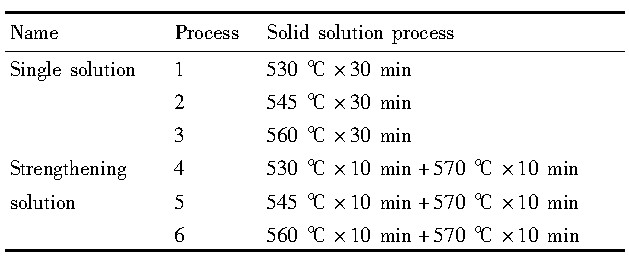
表5 2099合金的固溶工艺与时效工艺Table 5 Solid solution and aging process of 2099 alloy
图4 不同固溶条件下2099合金时效态的力学性能Fig.4Mechanical property of 2099 alloy under different solid solution conditions with aging state
图5为固溶与时效工艺对2099合金力学性能的影响幅度。可以看出, 固溶温度升高对合金强度指标的贡献呈递减趋势。其中, 工艺6对应合金的屈服强度和抗拉强度降幅最大, 分别为44和56MPa。合金时效态的强度指标随着固溶/预固溶温度的升高而增大, 在工艺2~6范围内, 合金的屈服强度和抗拉强度增幅分别在160~170 MPa和259~262 MPa范围内波动。对比发现, 不论是固溶态还是时效态, 不同固溶/预固溶温度对工艺1~2的强度指标影响较为明显, 而对于工艺3~6的强度指标影响甚微。由图5 (b) 发现, 单级固溶条件下, 随着固溶温度的升高合金的塑性得到明显的改善;强化固溶条件下, 随着预固溶温度的升高合金塑性的增幅出现降低。强塑性指标的变化趋势与幅度与合金在固溶和时效过程中晶粒大小变化、二相粒子回溶效果以及基体强化相的大小、分布密切相关。
图6为2099合金在单级固溶工艺下, 电子束沿[011]Al方向的暗场像与电子衍射花样。不同单级固溶条件下, 基体中的析出相主要以T1相为主, δ'相以及δ'/β'复合相次之, 同时伴有少量的θ'相。在530℃保温30 min, 如图6 (a) 所示, 基体中主要分布着长宽比较大的、呈板条状、沿{111}Al面析出的T1相, 还可观察到少量的长宽比较小的板条, 沿{100}Al面析出的半共格θ'相, 以及少量的球形δ'相和略显粗大的δ'/β'复合相。温度升高到545℃保温30 min, 如图6 (b) 所示, 基体中T1相的密度明显增加, 而θ'相和δ'相的数量、尺寸、形貌变化较小。温度达到560℃保温30 min, 如图6 (c) 所示, T1相的数量和尺寸均没有发生明显变化, 呈球形的δ'相和δ'/β'复合相在尺寸和数量上略有增加。对比发现, 固溶温度由530℃上升到560℃, T1相的密度呈递增趋势, 当固溶温度超过545℃后, T1相的密度和尺寸保持基本稳定。这表明, 固溶温度超过545℃时, 合金的过饱和度基本相当, 强化相在析出过程中的驱动力相差不大。因此, 析出相的大小、形貌和分布在545℃以上表现出类似的特征。
图7为2099合金在不同的强化固溶工艺下, 电子束沿[011]Al方向的暗场像与电子衍射花样。可以发现, 合金基体中的析出强化相仍以T1相为主, 同时可以观察到少量的θ'相、δ'相以及较大的球形δ'/β'复合相。预固溶温度由530℃上升到545℃, 基体中T1相的数量、大小、形貌变化较小, 而θ'相、δ'相以及δ'/β'复合相等亚稳相的数量减少, 如图7 (a) 和 (b) 所示。预固溶温度升高到560℃时, T1相的密度增加, 尺寸减小, 分布较为弥散, 但并不均匀, 细小弥散的T1相对合金的析出强化效果贡献最大, 而θ'相、δ'相以及δ'/β'复合相的变化并不明显, 如图7 (c) 所示。对比发现, 随着预固溶温度的升高, T1相的密度增大, 尺寸减小, 这表明强化固溶提高了合金的过饱和度, 强化了时效动力学, 析出强化相分布更为细小弥散。
图5 固溶与时效工艺对2099合金力学性能的影响幅度Fig.5 Effect extent of solid solution and aging process on mechanical property for 2099 alloy
(a) Rm, Rp0.2; (b) A25 mm
图6 不同单级固溶工艺下2099合金的暗场像与电子衍射花样Fig.6 Dark field images and electron diffraction patterns of 2099 alloy with different single solution process
(a) , (d) Process 1; (b) , (e) Process 2; (c) , (f) Process 3
图7 不同强化固溶工艺下2099合金的暗场像与电子衍射花样Fig.7 Dark field images and electron diffraction patterns of 2099 alloy with different strengthening solution proces
(a) , (d) Process 4; (b) , (e) Process 5; (c) , (f) Process 6
3 结论
1.挤压态合金中分布着几微米到十几微米且形貌各异的第二相, 如呈板条状和球形的Al-CuMg相, 以及粗大无规则的Al-Cu-Mn-Fe脆性相。
2.固溶态下, 随着固溶或预固溶温度的升高二相粒子的回溶效果明显改善, Al-Cu-Mn-Fe相尺寸减小、数量减少, 但尚未完全回溶;合金的强度随着固溶或预固溶温度升高而降低, 而塑性获得不同程度的提高。
3.时效态下, 随着固溶或预固溶温度升高, 合金的塑性指标降低, 对时效强化的贡献呈缓慢递增;时效析出相演化规律表现为:T1相的密度增大, 尺寸减小, θ'相、δ'相及δ'/β'复合相等亚稳相所占比例减小。
参考文献


